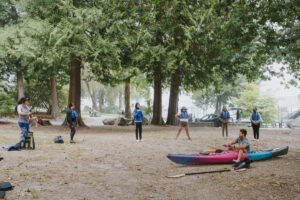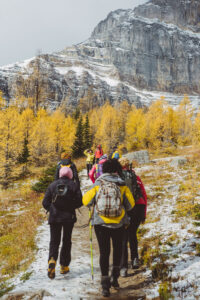
In collaboration with BC AdventureSmart
We are so glad that more and more BIPoC folks are becoming comfortable venturing into the outdoors. Whether that be a hike when the weather warms up, enjoying winter sports like snowshoeing or skiing, or taking a kayak out onto the water. We want everyone to be able to prioritise their safety and take the necessary precautions when heading out, so that you are prepared for a change in weather, an emergency, or getting lost.
Things we recommend you do before you head out – plan your trip, ensure you have the skills and capacity for your adventure, and always take necessary and preparatory items with you.
These things are broken down into 3Ts – trip planning, training, and taking the essentials.

Trip Planning
- Be familiar with your travel route
- Know the terrain and conditions
- Check the weather
- Always fill out a trip plan
Check sites for the length, approximate skill level, and length a trip could take. Some websites are Vancouver Trails or All Trails for hikes, and BC Parks or Alberta Parks for camping. Look for the ones specific to your area. Become familiar with what the weather is like on that day or weekend, but also be aware that mountain weather isn’t the same as the weather in the city, and can be far more unpredictable so pack extra layers.
When filling out a trip plan, let people know where you are going and when to expect you back. AdventureSmart let’s you fill out a plan on their website, or you can download the app – AdventureSmart Trip Plan. It is available on both iOS and Android.
Training
- Obtain the knowledge and skills you need before venturing out
- Know and stay within your limits

If you are heading out for winter sports – snowshoeing, skiing, snowboarding or snowmobiling – knowing how to read alpine terrain and ensuring that you have avalanche training are some of the ways you can prepare yourself, especially if you’re heading out into the backcountry. If you are within ski resort parameters, do not go out of bounds.
This also applies to hiking – do not wander off the trail and stick to your hiking plan. Following the route you planned to hike is critical to your route finding. If an emergency were to occur, and Search and Rescue (SAR) are looking for you, they’ll refer to your trip plan that you filed, and check that route. By not following your plan, it’s very difficult for SAR to locate you.
And be mindful, if a trail is too long or night fall is approaching and you are not prepared, turn around and return to your vehicle.
Taking the Essentials
- Flashlight/Headlamp
- Fire making kit
- Signalling device (i.e. whistle)
- Extra food and water
- Extra clothing
- Navigational/communication devices
- First aid kit
- Emergency blanket/shelter
- Pocket knife
- Sun protection
Taking these essentials will always be of use so ensure to carry them and know how to use them, especially with season and sport specific gear that may not be included on this list. Consider acquiring other navigational/communication gear beyond your phone as this could get wet or the battery could die.

What to do in the case of an emergency?
If you are in a safe location – S.T.O.P. – stop, think, observe, plan then act.
In the case of a fall or an injury, it is better to conserve your body’s energy, and if you happen to get lost, staying put where you are is the best approach for Search and Rescue (SAR) to easily find you.
Call 911 if your phone has battery and even little to no network, as it could still go through. This will aid SAR, which is a free service.
Want to learn more about SAR responses? Consider watching Search and Rescue: North Shore on the Knowledge Network.

Engaging with the outdoors, as much as it is about enjoyment, adventure and engaging with nature, is also about respecting the surrounding terrain and wildlife and you being responsible to ensure safety.
If you go exploring make sure you have the essentials and know what is required for your chosen activity. If you are in a group, remind others of what’s needed before heading out and fill out your trip plan. Use the AdventureSmart app!
To learn more about safety for outdoor activities and personal preparedness visit AdventureSmart.ca and look for @BCAdvSmart on Twitter, Instagram and Facebook.
